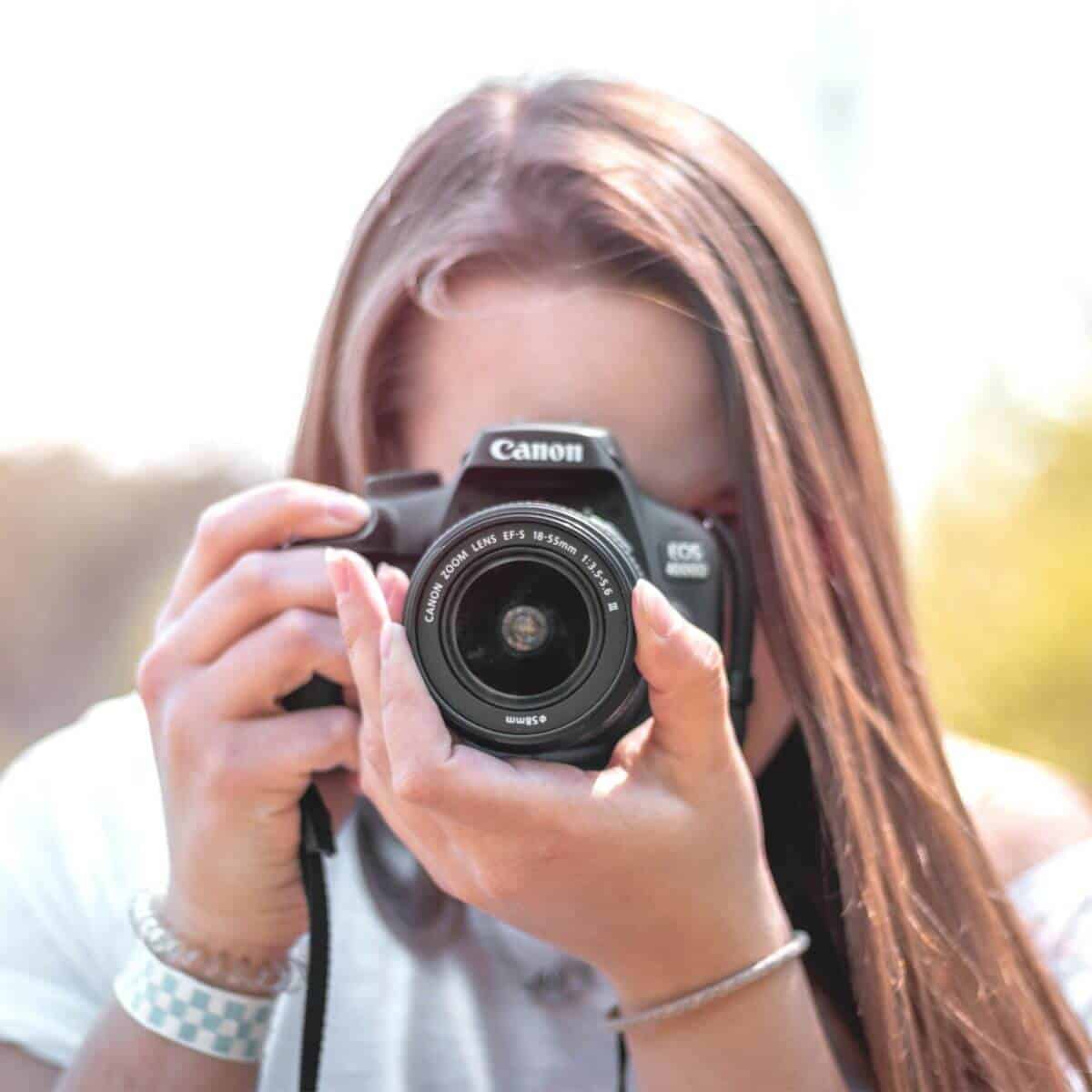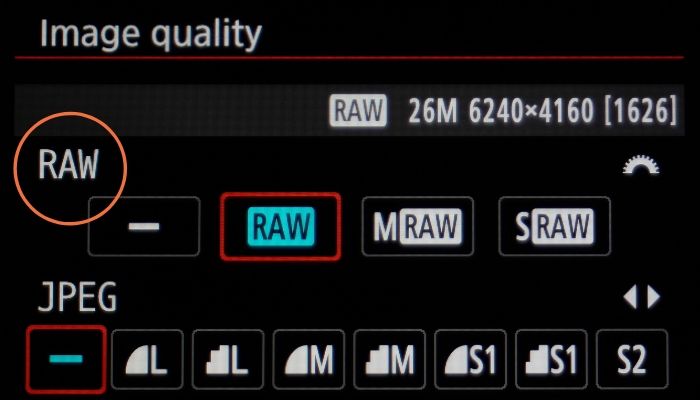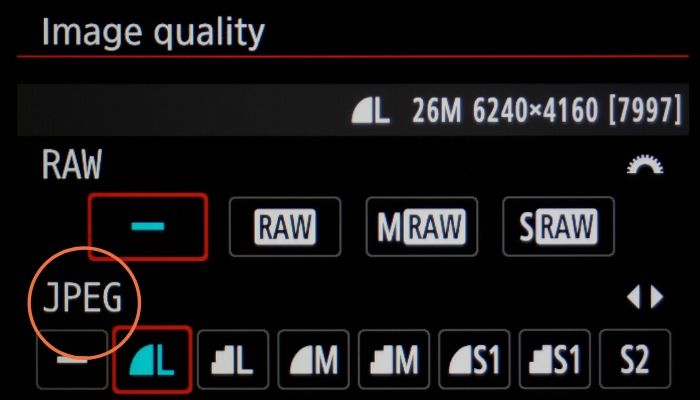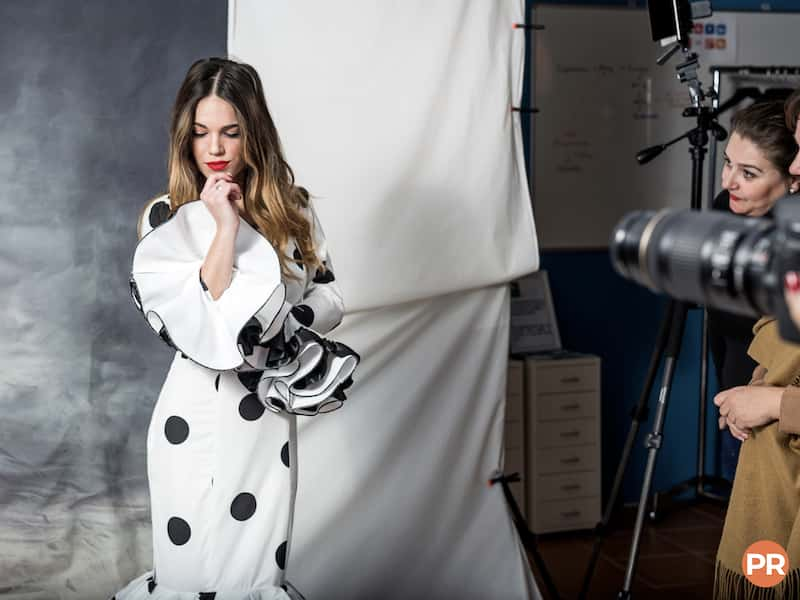RAW and JPEG are file formats that most digital cameras use for saving images. Learn the differences to choose the best one for your needs.

When you take a picture with a digital camera or phone, it uses a file format to save the image.
Most are JPEG, but you can change them to a RAW file format.
JPEG is the creation of the Joint Photographic Experts Group. The camera compresses the file, unlike a RAW photo.
The following covers everything you need to know about RAW and JPEG file formats. You’ll learn which is best for you.
What’s a RAW file?

A RAW file is uncompressed and unprocessed.
It’s not yet an image and must go through post-processing software. Then, you can view, print, or share the RAW file.
You can use Adobe Photoshop, Lightroom, Capture One, and Luminar to convert a RAW file into a JPEG or PNG.
Shooting in RAW captures all image details that the sensor captures. It also results in large file sizes and lossless quality.
When shooting in RAW, your camera will process the image and show you a JPEG preview.
Without the camera processing it, there’s no sharpening or changes to the contrast.
RAW files look flat, dull, and unimpressive. Through post-processing, you can get dynamic and beautiful results.
Benefits of RAW
When you get a camera, the standard file format is likely JPEG. One of the best things you can do is switch it to RAW.
Most professional photographers shoot in RAW because it provides the highest-quality images.
It retains all the image data from the sensor, giving you editing flexibility.
An excellent benefit of shooting in RAW is the ability to capture more shades of color.
An 8-bit JPEG has 256 shades of red, blue, and green. The number increases if you switch your camera to RAW, leading to 12, 14, or 16 bits.
A 12-bit RAW file captures 4,096 shades, and 16 bits have 65,536.
Aside from colors, a RAW file gives your images a better dynamic range. Also, more data leads to powerful editing.
You can correct exposure issues, recover lost details, and achieve better noise reduction.
You can bring back the parts of the image with underexposure or overexposure.
Since RAW files produce high-quality images, it’s the best format to print your photos.
Aside from photo quality, shooting in RAW protects your creative property.
You can manipulate JPEG files, but it’s hard to do for RAW files. It can prove your ownership and the authenticity of an image.
Drawbacks of RAW
While RAW files offer outstanding benefits, there are limitations and drawbacks.
By collecting all the image data, shooting in RAW leads to a larger file size.
It takes up more space, meaning your memory card will fill faster than it would with JPEG files.
Use a memory card with more capacity or pack extras if you plan to shoot in RAW.
Another drawback is that it takes more time and effort. Image processing is a must, not an option.
Before switching your camera to RAW, ensure you have time to edit each photo and have a good workflow.
Sharing limitations and software compatibility are also potential drawbacks.
When using Canon’s RAW format (CR2 or CR3), you can’t use Nikon’s software to open the file.
Instead, use Canon’s software or a compatible third party like Adobe.
Before sharing a RAW file, you must put it through post-processing software. Otherwise, the other person must have compatible software.
What’s a JPEG file?

JPEG is the standard file format for digital photography. A JPEG file uses lossy compression to make file sizes smaller.
The camera processes the image as soon as you capture it.
The edits include noise reduction, sharpening, saturation, and contrast adjustments.
Then, the photos are ready for viewing, sharing, and printing out of the camera.
When shooting in JPEG, you can choose the level of quality.
Cameras offer different percentages. They affect the quality and size of the JPEG file.
Benefits of JPEG
When deciding between RAW and JPEG, there are times to choose JPEG.
A JPEG file undergoes processing in the camera, giving it a smaller footprint and saving you time.
Instead of putting in hours editing the photo, the camera does it for you.
It adjusts the contrast, tone curve, and saturation. You can view, share, or display the image right away.
The small file size also uses less space on your memory card and storage.
You can focus on taking pictures without worrying about taking too many.
Versatility is another benefit of JPEG. The internet, most software, and devices can view JPEG files.
When using JPEG, you only need to focus on nailing the exposure, composition, and white balance.
Drawbacks of JPEG
JPEG is an efficient file format, but some reasons may lead you to shoot in RAW.
The main drawback of JPEG is the quality lost in the lossy compression process.
Converting RAW to JPEG in post-processing gives you better quality.
Another reason to use RAW is that JPEG is 8-bit. It limits the colors to 16.8 million possibilities.
You can capture more tonal values with RAW.
The camera settings must also be spot-on when using JPEG. There are recovery and editing limitations.
Once the camera creates the JPEG, you can’t undo it.
How to choose between RAW and JPEG

Your choice between RAW and JPEG affects the outcome of your photos.
Both file formats have benefits and drawbacks. So, choose one that fits your needs.
JPEG is best for efficiency. It’s ideal if you need to capture photos quickly, can nail the settings, and want to pass on post-processing.
RAW is best for quality. It’s excellent if you intend to edit the images after a session or print them.
RAW files are the highest quality and give you creative control to achieve your vision.
If you can’t decide, you can use both RAW and JPEG at once. Be sure to carry an extra or high-capacity memory card.
Frequently asked questions about RAW and JPEG
Do professional photographers use RAW or JPEG?
Most professional photographers choose RAW over JPEG. RAW files keep all the information that the sensor records. It allows you to make powerful edits and recover lost details in highlights and shadows. You can also get a better dynamic range from a RAW file.
Should I shoot in both RAW and JPEG?
If you want flexibility and choices, shoot in RAW and JPEG. Using both file formats allows you to decide which looks best.
Do you have to edit a RAW file?
When you take a photo, it will undergo processing. The JPEG file format means the camera will process the image. The RAW file format means you process it by editing or converting it to a JPEG file. If you shoot in RAW, editing is necessary.
Conclusion
Digital cameras give you two options for saving images, RAW and JPEG files. You can also save both file formats for each image.
Choose the JPEG file format if you want the camera to process the picture for you.
Choose RAW to edit the photo in post-processing. It retains all the information the camera sensor records and offers creative control.
Now that you understand the differences, you can choose the ideal one for your needs.
Related: How to Take Stunning Senior Pictures
Featured image courtesy of Unsplash.
